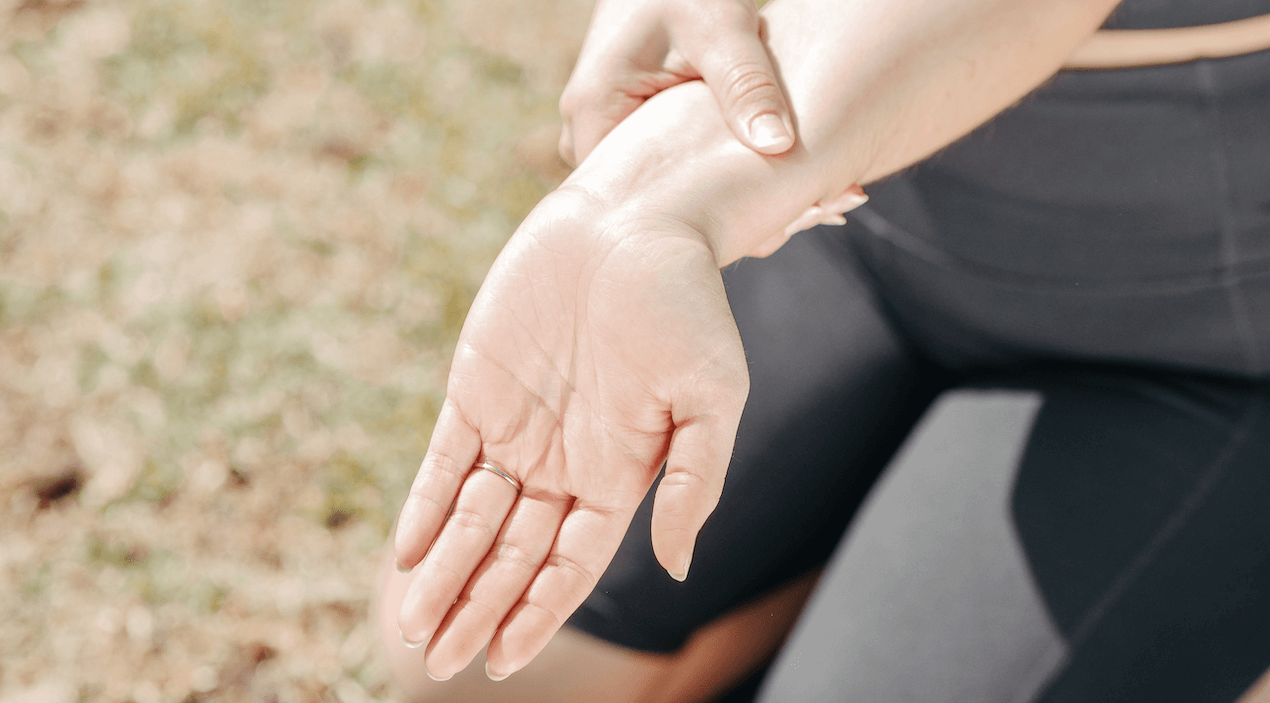It is unfortunately quite common for people who work office jobs to experience some form of arm pain in their careers. This is especially true for those who continue to work from home in workstations that are not ergonomically correct. Check out our new Virtual Ergonomic Assessments to learn more about the importance of a proper workstation and how we can help get you there. With a few ergonomic modifications and bracing, our physiotherapist teams in Baden, Kitchener (Lancaster and Driftwood), and Waterloo can help you find some relief without sacrificing work performance. Here are the most common problem areas and their initial steps for relief that we treat in our patients’ hands and arms.
Area #1: Palm Side of the Wrist
You may feel pain on the side of your wrist that occurs after repeated use of your hand or arm. This pain can travel along your palm, thumb, index, and long finger. It can also radiate and may involve numbness and tingling sensations in these areas. Common causes include carpal tunnel syndrome, tendinitis, and arthritis; all of which require treatments that will likely involve limiting motion of the wrist and repetitive actions. It is important to note that any extreme motions or prolonged repetitive activity will often make your symptoms feel worse. Try to keep your wrists in a neutral position (straight out from your forearm) while working at a desk. To do this, move your laptop or keyboard to the centre of your desk so that both of your wrists and forearms lay flat on your desk. We may also recommend a wrist brace to be worn at night to prevent you from sleeping with your wrists flexed.

Area #2: Backside of the Wrist
Another area you may feel more consistent pain is directly at the base of your thumb. This can be caused by arthritis or synovitis and the pain is often worse after prolonged pinching, gripping, or holding of objects. Another type of wrist pain can be associated with inflammation of the tendon – this pain will be localized more towards your wrist than your hand and is often worsened by moving your wrist from side to side. This type of pain is usually associated with new mothers who are lifting their babies. We usually recommend wearing braces, called thumb spica braces, that limit your thumb motions and can be made both as a soft brace or rigid one depending on your needs at work.
Area #3: Pinky Finger Side of the Wrist
This pain can be more complicated because it is often associated with your ulnar nerve becoming compressed. You may feel numbness that is relieved by changing the position of your wrist or elbow. It is often caused by tendon or ligaments inflammation and bending your elbow for prolonged periods of time – like while working at a desk. If the pain or numbness persists, it often requires a more thorough examination by a hand professional to prevent any possibility of nerve damage. Again, a rigid brace is often prescribed to limit repeated ulnar deviation at the wrist.

Area #4: Outside of the Elbow
Tennis elbow is the most common cause of pain located on the outside of your elbow and is related to prolonged periods of sitting at a desk. The pain tends to be worse at the end of the day after repeated use and can be dull but sometimes radiates into more acute pain. Since all the muscles that allow your fingers and wrist to extend begin on the outside of your elbow, it is easy for this area to become inflamed. To treat tennis elbow, we often focus on your workspace ergonomics and make sure you take work breaks throughout the day. Try to complete some tasks at work with your palm facing upwards (since then your flexor muscles are being used instead of your extensor muscles) and wear a night wrist brace to prevent you from stretching and straining your extensor muscles overnight.
Area #5: Inside of the Elbow
The two most common causes of medial elbow pain are tendinitis and palm compression of the ulnar nerve. Having your elbows flexed at 90 degrees for extended periods of time can lead to numbness in your small and ring fingers. This pain can also develop and radiate into your forearm and fingers. Again, workspace ergonomics and bracing will often help your pain. We recommend trying to keep your elbow only slightly flexed the prevent extra strain on your nerve. To accomplish this, you can move your mouse or keyboard further away from your body so that your elbows are in a straighter position and you are putting less pressure on them. Wearing a wrist brace at night can help diminish your symptoms as they prevent you from flexing while asleep which gives your flexor muscles a break to recover from the workday.

Area #6: Back of the Elbow
There is not a lot of tissue padding on the backside of your elbow to protect your bone from harm. You may experience pain directly over the elbow bone that is associated with olecranon bursitis. This can be caused by inflammation or infection and both lead to swelling. Olecranon bursitis involves a small sac of fluid filling the area on the backside of your elbow bone (again because of the lack of padding) that can occur without any trauma. Inflammation, irritation, and infection are the main culprits of olecranon bursitis. Elbow wrapping with a compression sleeve is often prescribed if the area is swollen without significant warmth. However, we always warn our patients about compressing the area too tightly which could prevent proper blood flow to the rest of your arm.
—
We hope that this blog helps you better understand why you may be experiencing pain in your hands and arms while working from home or at the office. If you find yourself distracted by your pain, then it is time to contact our team – don’t let your work performance or overall health suffer when it does not have to! Remember to check out our Virtual Ergonomics Assessments to reduce the risk of pain or injury while enhancing your productivity, quality of work, safety, and comfort.
Give us a call at (519) 880-1733 or fill out our contact form with any questions and to learn how physiotherapy can enhance your overall quality of life. We’re also always happy to help answer any general physiotherapy and wellness questions, provide you with health tips, and schedule a consultation. Just ask!

